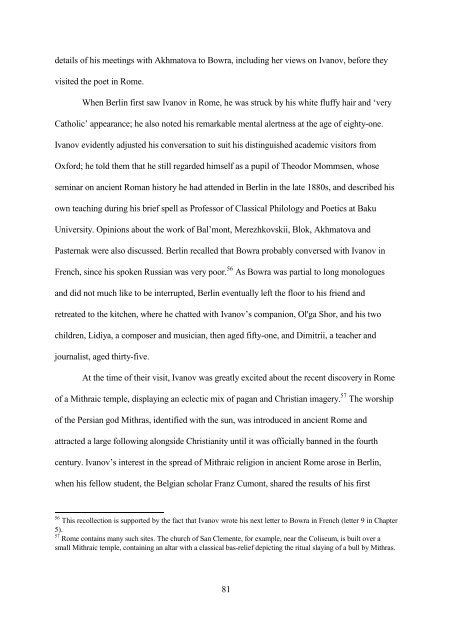Vyacheslav Ivanov and C.M. Bowra: a ... - UCL Discovery
Vyacheslav Ivanov and C.M. Bowra: a ... - UCL Discovery
Vyacheslav Ivanov and C.M. Bowra: a ... - UCL Discovery
You also want an ePaper? Increase the reach of your titles
YUMPU automatically turns print PDFs into web optimized ePapers that Google loves.
details of his meetings with Akhmatova to <strong>Bowra</strong>, including her views on <strong>Ivanov</strong>, before they<br />
visited the poet in Rome.<br />
When Berlin first saw <strong>Ivanov</strong> in Rome, he was struck by his white fluffy hair <strong>and</strong> ‘very<br />
Catholic’ appearance; he also noted his remarkable mental alertness at the age of eighty-one.<br />
<strong>Ivanov</strong> evidently adjusted his conversation to suit his distinguished academic visitors from<br />
Oxford; he told them that he still regarded himself as a pupil of Theodor Mommsen, whose<br />
seminar on ancient Roman history he had attended in Berlin in the late 1880s, <strong>and</strong> described his<br />
own teaching during his brief spell as Professor of Classical Philology <strong>and</strong> Poetics at Baku<br />
University. Opinions about the work of Bal’mont, Merezhkovskii, Blok, Akhmatova <strong>and</strong><br />
Pasternak were also discussed. Berlin recalled that <strong>Bowra</strong> probably conversed with <strong>Ivanov</strong> in<br />
French, since his spoken Russian was very poor. 56 As <strong>Bowra</strong> was partial to long monologues<br />
<strong>and</strong> did not much like to be interrupted, Berlin eventually left the floor to his friend <strong>and</strong><br />
retreated to the kitchen, where he chatted with <strong>Ivanov</strong>’s companion, Ol'ga Shor, <strong>and</strong> his two<br />
children, Lidiya, a composer <strong>and</strong> musician, then aged fifty-one, <strong>and</strong> Dimitrii, a teacher <strong>and</strong><br />
journalist, aged thirty-five.<br />
At the time of their visit, <strong>Ivanov</strong> was greatly excited about the recent discovery in Rome<br />
of a Mithraic temple, displaying an eclectic mix of pagan <strong>and</strong> Christian imagery. 57 The worship<br />
of the Persian god Mithras, identified with the sun, was introduced in ancient Rome <strong>and</strong><br />
attracted a large following alongside Christianity until it was officially banned in the fourth<br />
century. <strong>Ivanov</strong>’s interest in the spread of Mithraic religion in ancient Rome arose in Berlin,<br />
when his fellow student, the Belgian scholar Franz Cumont, shared the results of his first<br />
56<br />
This recollection is supported by the fact that <strong>Ivanov</strong> wrote his next letter to <strong>Bowra</strong> in French (letter 9 in Chapter<br />
5).<br />
57<br />
Rome contains many such sites. The church of San Clemente, for example, near the Coliseum, is built over a<br />
small Mithraic temple, containing an altar with a classical bas-relief depicting the ritual slaying of a bull by Mithras.<br />
81
















